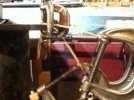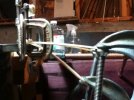- Joined
- Aug 29, 2010
- Messages
- 13,915
For Ebony? Nothing. Oils won't penetrate the grain. You could use a wax but that can sometimes make a buffed handle feel sticky.
Sometimes less is more.
Sometimes less is more.
The BladeForums.com 2024 Traditional Knife is ready to order! See this thread for details:
https://www.bladeforums.com/threads/bladeforums-2024-traditional-knife.2003187/
Price is $300 $250 ea (shipped within CONUS). If you live outside the US, I will contact you after your order for extra shipping charges.
Order here: https://www.bladeforums.com/help/2024-traditional/ - Order as many as you like, we have plenty.
Take that piece of red oak scrap out of the oil and let it drain. Give it a brief dunk every couple months. If it hasn't been previously treated to block oil absorption, it should turn pretty ugly in the next few years.Everything I've read about ebony suggests it's generally so dense, any 'finish' applied, oil or other, doesn't really penetrate at all. And by extension, because of it's natural density and (maybe) it's own oils, it really doesn't need anything else anyway. This isn't to say a finish like polyurethane couldn't be applied as a wear-resistant coating on the surface, per se. But I don't think much is needed on ebony to protect it, otherwise.
As for mineral oil, different woods handle it differently; some with no ill effects whatsoever. I have a scrap of 3/4" red oak I dropped into the oil bath bin I keep my oilstones in, to satisfy my curiosity about the effects of the oil on it. I did that a couple or more years ago, and that scrap of red oak has lived in there, submerged 24/7, ever since. Hasn't been fazed by it at all; no softening, no swelling, nothing. Woods differ greatly in their fibrous makeup, and some will absorb a lot of oil or other moisture, whereas other woods won't. I have noticed that the wood block (of unknown wood type) which supports my Tri-stone sharpening setup has softened over time, with the liberal use of mineral oil on the stones during sharpening. But otherwise, it hasn't swollen noticeably, nor is it falling apart or otherwise disintegrating as seems to be a fear for some. Curiously, the triangular wood block onto which the 3 stones are epoxied has NOT shown any of the same effects as seen with the base support.
As for application of mineral oil, I've yet to see any of my wood-handled knives harmed by a light sheen of it applied maybe 2 or 3 times a year. No soaking in it is necessary. Just a drop or two applied to the wood, rubbed in with the fingertips and allowed to sit for a few minutes, then wiped of the excess that hasn't penetrated. That's all I've ever done or needed for my knives handled in wood. Just enough to keep them from drying & cracking in my arid southwestern USA climate.
Here is a new photo more than twenty four hours later.To see what we could see.
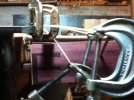
But that is not what we have here. There is still enough oil on the popsicle stick that it will make my finger a little wet when I pass my finger over the surface.Something that hit me after the fact : The thin coating we would wipe on and soon wipe off a knife handle would be so minuscule and shallow that it could not possibly effect the strength of the knife.
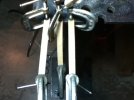
A bit of side trivia :Kiwi black shoe polish. Very sparingly applied and buff it good.
Just for conversation . . . was that oil plain mineral oilTake that piece of red oak scrap out of the oil and let it drain. Give it a brief dunk every couple months. If it hasn't been previously treated to block oil absorption, it should turn pretty ugly in the next few years.
Those timbers I mentioned earlier were oak, not sure if it was red or white. They were just sitting in an inch of oil. I've seen the same thing happen to oak pallets that set on an oil soaked floor for a long time.
Gearbox oil. Not sure the viscosity but was non detergent.Just for conversation . . . was that oil plain mineral oil
or
was it motor oil for internal combustion engines with detergents and oh I don't know what all "magic" additives in it that might attack the wood ?
Maybe it was USED motor oil which we all know is JUST CHOCK FULL of lethal, as well as wood eating, mutant chemicals.
I'm mostly kidding but it might make some difference.
Well perhaps more than one photo.From here I will give it a full week and then another photo. I don't want to over do it.
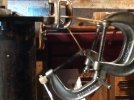
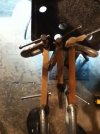
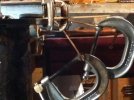
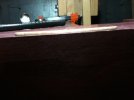
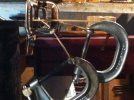
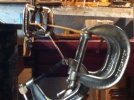
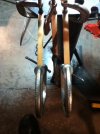
Extreme short term exposure looks great so far.A couple of days later.
Not exactly a race to the bottom is it ?
